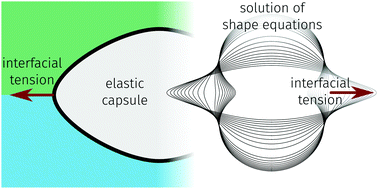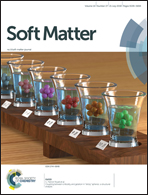Elastic capsules at liquid–liquid interfaces
Abstract
We investigate the deformation of elastic microcapsules adsorbed at liquid–liquid interfaces. An initially spherical elastic capsule at a liquid–liquid interface undergoes circumferential stretching due to the liquid–liquid surface tension and becomes lens- or discus-shaped, depending on its bending rigidity. The resulting elastic capsule deformation is qualitatively similar, but distinct from the deformation of a liquid droplet into a liquid lens at a liquid–liquid interface. We discuss the deformed shapes of droplets and capsules adsorbed at liquid–liquid interfaces for a whole range of different surface elasticities: from droplets (only surface tension) deforming into liquid lenses, droplets with a Hookean membrane (finite stretching modulus, zero bending modulus) deforming into elastic lenses, to microcapsules (finite stretching and bending modulus) deforming into rounded elastic lenses. We calculate capsule shapes at liquid–liquid interfaces numerically using shape equations from nonlinear elastic shell theory. Finally, we present theoretical results for the contact angle (or the capsule height) and the maximal capsule curvature at the three phase contact line. These results can be used to infer information about the elastic moduli from optical measurements. During capsule deformation into a lens-like shape, surface energy of the liquid–liquid interface is converted into elastic energy of the capsule shell giving rise to an overall adsorption energy gain by deformation. Soft hollow capsules exhibit a pronounced increase of the adsorption energy as compared to filled soft particles and, thus, are attractive candidates as foam and emulsion stabilizers.



 Please wait while we load your content...
Please wait while we load your content...